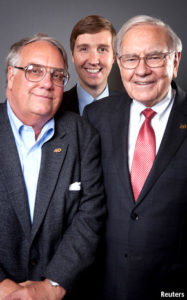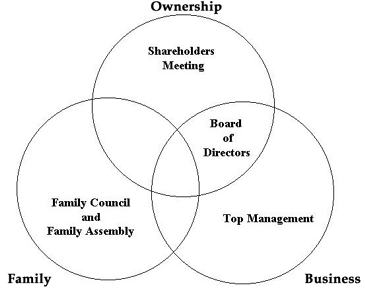Originally published in The Economist (November 2014)
THE “Lucky Sperm Club”, as Warren Buffett likes to call it, is still going strong in the commanding heights of business. On opposite sides of the Atlantic, Ana Botín and Abigail Johnson have recently succeeded their fathers in filling two of the most powerful jobs in finance, as chairman of Banco Santander and chief executive of Fidelity Investments, respectively.
Founding dynasties run, or wield significant clout at, some of the world’s largest multinationals, from Walmart to Mars, Samsung to BMW. Half a century ago management experts expected the hereditary principle to fade fast, because of the greater ability of professionally-run public firms to raise capital and attract top talent. In fact, family firms have held their ground and, in recent years have increased their presence among global businesses.
Family-controlled firms now make up 19% of the companies in the Fortune Global 500, which tracks the world’s largest firms by sales. That is up from 15% in 2005, according to new research by McKinsey, a consulting firm (which defines such firms as ones whose founders or their families have the biggest stake, of at least 18%, plus the power to appoint the chief executive). Since 2008 sales by these firms have grown by 7% a year, slightly ahead of the 6.2% a year by non-family firms in the list. McKinsey sees these trends continuing for the foreseeable future.
This is largely because of rapid growth in big developing economies where family ownership is the norm among large businesses. Since 2005 the countries that have most increased their share of the Fortune Global 500 are Brazil, China, Russia, South Korea and Taiwan. By 2025, McKinsey forecasts, there will be more than 15,000 companies worldwide with at least $1 billion in annual revenues, of which 37% will be emerging-market family firms. In 2010 there were only 8,000 firms worldwide of this size, and only 16% of them were family-controlled and from emerging markets.
Around 85% of $1 billion-plus businesses in South-East Asia are family-run, around 75% in Latin America, 67% in India and around 65% in the Middle East. China (where the proportion is about 40%) and Sub-Saharan Africa (35%) stand out for their relatively low share of family firms, because in both cases many large firms are state-owned.
However, even in the rich world, big family firms are defying expectations of their demise. The tendency for founders and their heirs to abandon control to faceless institutional shareholders seems to have reached a limit. Of the American firms in the Fortune Global 500, 15% are family ones, only slightly less than in 2005. Among them is the world’s largest family firm, Walmart, in which the children of the late founder, Sam Walton (pictured, third from left) are still big shareholders. His eldest son, Rob, is the chairman, another son, Jim, is also on the board and their sister, Alice, also inherited a huge stake. In Europe, 40% of big stockmarket-listed companies still have a controlling family.
Until recently many emerging economies lacked the large, liquid capital markets that rich countries enjoy. So local firms could not rely on them to provide funds for expansion, and depended instead on founding families reinvesting their profits. As such firms’ access to domestic and global stock and bond markets continues to improve, it is possible to imagine this situation changing; family owners could seize the opportunity to make a lucrative exit, as happened for a time in the rich world.
However, one reason why the experts’ predictions of 50 years ago have proved wrong is that stockmarkets and regulators have been so accommodating in letting founding families retain a fair degree of control despite selling large stakes to outside investors. One way they have done so is through special classes of shares—a trend that has lately featured in a number of technology-firm flotations: who knows, perhaps in future Facebook will be controlled by the Zuckerberg dynasty and Google by the Page and Brin clans. Investors have accepted such arrangements as the price of getting a slice of these firms’ profits, but they rarely like them.
Besides being able to access capital markets without losing control, there are at least four other reasons why so many big firms have defied expectations and stayed under family control. One is that they are often the product of a superbly talented entrepreneur like Sam Walton. While such founders are alive and on form, the combination of their abilities and the freedom they have as controlling shareholder to run by their own rules often gives them a strong competitive advantage. Even after they are gone, their heirs can keep up the firm’s success, simply by continuing to follow the founder’s successful principles.

Whether private or public, family firms also tend to take a longer-term perspective. As Heinrich Liechtenstein of IESE business school in Barcelona observes, this is true both relative to non-family-controlled public companies, which tend to be obsessed with meeting the demands of investors to maximise short-term profits, and companies owned by private-equity firms, which although able to take a longer view than public firms must still cater to investors who want to sell up for a juicy profit within a few years.
Family firms are also less likely to load up on debt. An obvious exception, and an illustration of why most family capitalists fear debt, is the recent collapse of Espírito Santo. Massive debts turned the family-owned Portuguese financial conglomerate into one of Europe’s largest corporate failures, ending in a state bail-out of the bank at the group’s core. A reluctance to borrow may limit growth in good times, but it can make family firms more resilient when the going is tough.
They also tend to have better labour relations, according to studies by Holger Mueler and Thomas Philippon of New York University’s Stern business school. This may be because workers are readier to believe promises that they will be rewarded for delivering in the long run, if such pledges are made by founding families rather than outsider bosses who may be gone in a few years. And in situations where businesses have to push through efficiency improvements, family owners may be more willing to act firmly when dealing with labour unions, because of their significant stake in the business, than salaried outsider bosses, the studies suggest. These are advantages especially in countries with generally hostile relations between workers and management, say the two economists.
Overall, those family firms that get big tend to have a superior corporate culture to their non-family peers, reckons Heinz-Peter Elstrodt of McKinsey. The firm has applied its index of “organisational health” to 114 family firms and around 1,200 other large companies. Family firms scored significantly higher on their culture, worker motivation and leadership, though they lagged slightly on innovation and being too internally focused.
The presence of a founding family seems to be good for a business’s image. In a recent survey in 12 big economies by Edelman, a (family-run) PR firm, 73% of people said they trusted family-owned companies, compared with 64% who trusted publicly-traded companies in general, and 61% for both private-equity-owned and state-owned firms. This is no doubt why S.C. Johnson, a household-products maker, has as its slogan, “A Family Company”.
There is evidence of a positive “family effect” on financial performance, according to a new study by Cristina Cruz Serrano and Laura Nuñez Letamendia of IE business school in Madrid. They calculated that €1,000 invested in 2001 in a portfolio of publicly traded family firms in Europe, weighted by market capitalisation, would have generated €3,533 by the end of the decade, compared with €2,241 from a portfolio of non-family firms. The difference is equivalent to five percentage points of extra return per year.
 All this may be why, for all his professed disapproval of the Lucky Sperm Club, Mr Buffett wants his son, Howard (pictured, left, with his son, Howard Warren Buffett, an academic) to succeed him as chairman, and guardian of the firm’s culture. The elder Mr Buffett is such a big fan of family firms that he likes to buy them: in October he bought Van Tuyl Group, America’s largest family-owned car dealership chain. As with LVMH and Kering, two family-run French luxury-goods giants that have bought a number of European fashion houses, Mr Buffett’s spiel to founding families is: if you want to sell up but want your business’s culture preserved, it will be in safe hands with us.
All this may be why, for all his professed disapproval of the Lucky Sperm Club, Mr Buffett wants his son, Howard (pictured, left, with his son, Howard Warren Buffett, an academic) to succeed him as chairman, and guardian of the firm’s culture. The elder Mr Buffett is such a big fan of family firms that he likes to buy them: in October he bought Van Tuyl Group, America’s largest family-owned car dealership chain. As with LVMH and Kering, two family-run French luxury-goods giants that have bought a number of European fashion houses, Mr Buffett’s spiel to founding families is: if you want to sell up but want your business’s culture preserved, it will be in safe hands with us.
Ultimately, whether big family firms will continue to defy expectations of their demise will depend on their ability to negotiate the rocks on which family businesses have a unique propensity to founder. One is the risk of squabbles among relatives. This summer, for example, a family feud nearly destroyed Market Basket, an American supermarket chain. Workers went on strike when their popular boss, Arthur T. Demoulas, was fired at the behest of his cousin, Arthur S. Demoulas. Disaster was only averted after pleas to the family by the governors of Massachusetts and New Hampshire.
No issue is potentially more toxic than the transition from one generation of a family to the next. In India, an epic feud began in 2002 after Dhirubhai Ambani, the founder of Reliance Industries, died without naming a sole heir. The battle between his sons, Mukesh and Anil, eventually led to the group being split in two.
In some cases even strong and successful firms can implode soon after a generational succession, which is why so many countries have some variation of the saying, “from shirtsleeves to shirtsleeves in three generations” (clogs to clogs, kimono to kimono). Edelman’s survey found that the public’s trust in family firms falls once the baton is passed from the founder to the next generation. Alarmingly, a study of 2,400 family firms in 40 countries published last month by PwC, a consulting firm, found that only 16% of them had a “discussed and documented” succession plan in place.
The families that do best are those which understand that their interests and those of their business can diverge, and put in place processes to manage the consequences of these differences, says John Davis of Harvard Business School, the author of several books about family firms.
Some families are adept at training the next generation to work in the family firm. Illycaffé, a coffee-maker now run by a third-generation Illy family member, has a pact setting the rules for when an Illy can go into the business: competence for the job is paramount. Sweden’s Wallenberg business empire is run by a fifth generation of the founding family: two cousins, Jacob and Marcus Wallenberg, were groomed from an early age to run the group’s industrial and financial sides respectively.
However, sometimes children do not want to join the family business, or turn out not to have inherited the entrepreneurial genes of the founder. It may then be in the best interests of the firm for a professional to run it, rather than a reluctant or incompetent scion, even if the family retains some control. Letting professionals take over can make a lot of sense. Talented managers are more likely to join a firm where there is a chance of getting to the very top, or at least where they do not have to work under a useless heir. Some 40% of the family firms interviewed by PwC said that professionalising their business was among the main challenges they face in the next five years.
Even when they have agreed to let an outside manager run their businesses, families sometimes find it hard to keep their hands away from the wheel. Luxottica, an Italian maker of sunglasses, was well run by a professional chief executive for ten years, but recently lost him, and six weeks later his successor, reportedly following differences of opinion with the founder, Leonardo Del Vecchio, and his wife, Nicoletta Zampillo.
Even when independent outsiders are brought in to serve on a family company’s board, they can often fail to make the impact they should, notes Mr Davis. Outsiders often refuse to get involved in managing tensions within the family and assume their job is just to oversee the running of the business, when in reality they may be the last line of defence against a family breakdown destabilising the firm, he says.
In the rich world there is a strong contingent of firms which have demonstrated an ability to get the best out of being both family-controlled and professionally run. In some emerging markets, however, things are not so clear. Many of their big firms are still run by a founder with strong links to those in power, and only time will tell if they have what it takes to survive the passing of either the founder or the regime. However, the positive examples of Tata in India and Samsung in South Korea suggest that it is possible, even in places with a strong tradition of crony capitalism, for world-class, professionally run family firms to emerge.
As big emerging-market firms pass from the founders to their heirs, the challenge will be, as it has been in the rich world, to reconcile the family’s needs and desires with the demands of running a successful business. They will need to learn that when it comes to company matters, as Michael Corleone put it in “The Godfather”, that great study of a family firm, “It’s not personal…it’s strictly business.”
Correction: This article originally said that the late Emilio Botín had struck a deal which allowed his daughter, Ana, to succeed him as chairman of Santander. In fact, no such explicit agreement was struck, although Ms Botín does indeed now chair the Spanish bank.




 All this may be why, for all his professed disapproval of the Lucky Sperm Club, Mr Buffett wants his son, Howard (pictured, left, with his son, Howard Warren Buffett, an academic) to succeed him as chairman, and guardian of the firm’s culture. The elder Mr Buffett is such a big fan of family firms that he likes to buy them: in October he bought Van Tuyl Group, America’s largest family-owned car dealership chain. As with LVMH and Kering, two family-run French luxury-goods giants that have bought a number of European fashion houses, Mr Buffett’s spiel to founding families is: if you want to sell up but want your business’s culture preserved, it will be in safe hands with us.
All this may be why, for all his professed disapproval of the Lucky Sperm Club, Mr Buffett wants his son, Howard (pictured, left, with his son, Howard Warren Buffett, an academic) to succeed him as chairman, and guardian of the firm’s culture. The elder Mr Buffett is such a big fan of family firms that he likes to buy them: in October he bought Van Tuyl Group, America’s largest family-owned car dealership chain. As with LVMH and Kering, two family-run French luxury-goods giants that have bought a number of European fashion houses, Mr Buffett’s spiel to founding families is: if you want to sell up but want your business’s culture preserved, it will be in safe hands with us.